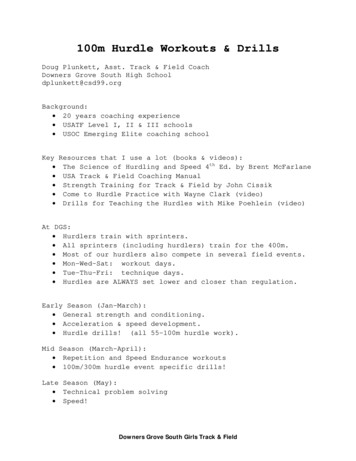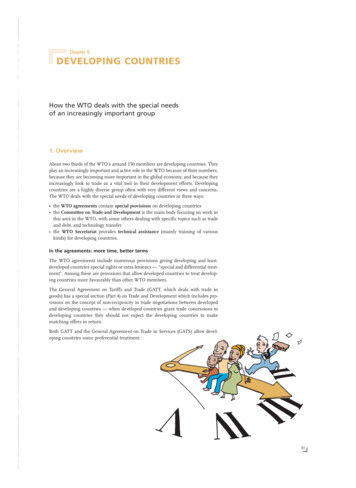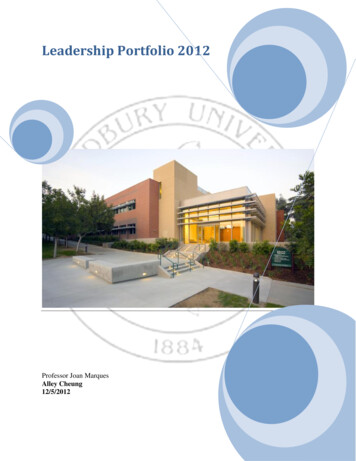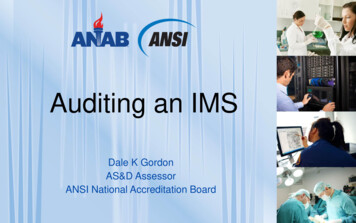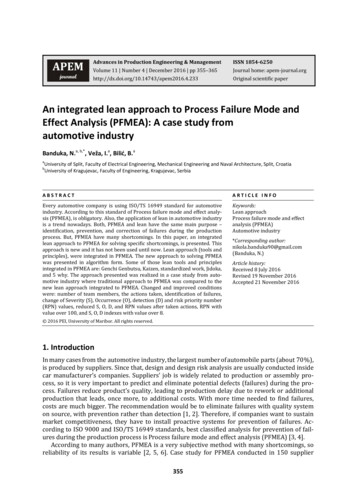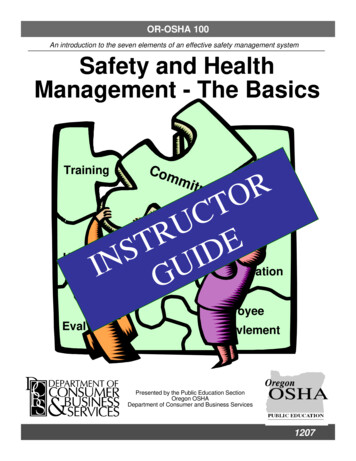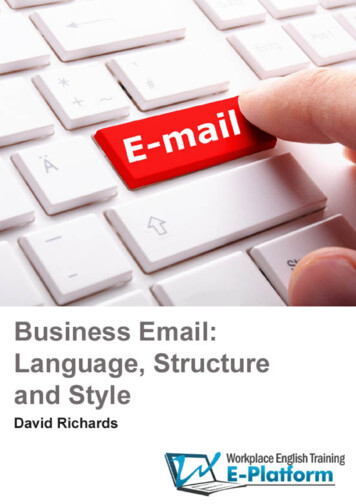
Transcription
Developing a Multiple HurdleApproach to HiringCatina Smith, Ph.D. & Amanda D. Angie, Ph.D.HR Research & Assessment DivisionU.S. Secret ServiceIPAC Conference July 2011Washington, D.C.U.S. Department ofHomeland SecurityUnited StatesSecret Service
Purpose & Objectives Discuss Considerations for Determining Selection Procedures Provide an Overview of Selection Strategy Options Discuss the Development and Use of a Multiple HurdleApproach to Hiring Provide Some Applied Examples of Multiple Hurdle SelectionSystems (including practice exercises)U.S. Department ofHomeland SecurityUnited StatesSecret ServiceAmanda D. Angie, Ph.D. & Catina M. Smith, Ph.D.HR Research & Assessment DivisionJuly 20112
You Have Identified the Job Now What?U.S. Department ofHomeland SecurityUnited StatesSecret ServiceAmanda D. Angie, Ph.D. & Catina M. Smith, Ph.D.HR Research & Assessment DivisionJuly 20113
Determine Your Selection Procedures There are several considerations to make when determiningyour selection procedures: What does the job look like? How many applicants will you have? How much time do you have to hire? How much will the process cost?U.S. Department ofHomeland SecurityUnited StatesSecret ServiceAmanda D. Angie, Ph.D. & Catina M. Smith, Ph.D.HR Research & Assessment DivisionJuly 20114
Assess the Job What does the job look like? Conduct job analysis – gathering information about a job inan organization Identify the critical KSAOs to bemeasured Link assessment type to KSAOs Identify operational requirements Extensive training Specialty skillsU.S. Department ofHomeland SecurityUnited StatesSecret ServiceAmanda D. Angie, Ph.D. & Catina M. Smith, Ph.D.HR Research & Assessment DivisionJuly 20115
Identify Your Applicant Pool How many applicants do you expect will apply for the position? Entry-level positions may attract large numbers ofapplicants Jobs requiring specialty skills, however, may have a muchsmaller number of applicants but may recruit from all overthe country and even the world (e.g., computerprogrammers, engineers, etc.)U.S. Department ofHomeland SecurityUnited StatesSecret ServiceAmanda D. Angie, Ph.D. & Catina M. Smith, Ph.D.HR Research & Assessment DivisionJuly 20116
Establish a Timeline for Hiring Consider the amount of time you can devote to the process: Do you need to fill the position immediately? A shorter, less time consuming process is probably best Are your hiring needs less urgent? A longer, more comprehensive process may beappropriate (i.e., specialty positions)U.S. Department ofHomeland SecurityUnited StatesSecret ServiceAmanda D. Angie, Ph.D. & Catina M. Smith, Ph.D.HR Research & Assessment DivisionJuly 20117
Calculate Cost How much will the selection process cost? Cost can be determined by: Assessment type and administration requirements E.g., paper-and-pencil tests tend to be less expensivethan interviews Applicant pool E.g., location of applicants and number applying Time for hiring E.g., a lengthy testing process can be expensiveU.S. Department ofHomeland SecurityUnited StatesSecret ServiceAmanda D. Angie, Ph.D. & Catina M. Smith, Ph.D.HR Research & Assessment DivisionJuly 20118
Why is this so Important? Minimizes selection decision errors: False positives – an applicant passes through all selectionphases and is hired, but is unsuccessful on the job False negatives – an applicant is rejected but would haveproved successful on the job Increases desired outcomes: True positives – an applicant passes through all selectionphases, is hired, and is successful on the job True negatives – an applicant is rejected and would nothave performed successfully on the jobU.S. Department ofHomeland SecurityUnited StatesSecret ServiceAmanda D. Angie, Ph.D. & Catina M. Smith, Ph.D.HR Research & Assessment DivisionJuly 20119
Next Steps Once you have considered the factors that influence yourselection procedures, how do you determine the selectionstrategy that best fits your needs? Choose a strategy that: Maximizes the potential of your assessments Provides a full view of the competencies you will measure May require more than one assessment Minimizes cost and provides quality applicants Fits your hiring timeframeU.S. Department ofHomeland SecurityUnited StatesSecret ServiceAmanda D. Angie, Ph.D. & Catina M. Smith, Ph.D.HR Research & Assessment DivisionJuly 201110
Selection Strategies Compensatory (a.k.a., Multiple Regression) All assessments are given to all applicants and scores arecalculated to arrive at a total score Multiple Cut-offs All assessments are given to all applicants and scored on apass-fail basis Combination Method All assessments are given to all applicants and the scores ofthose who pass are calculated and rank ordered Multiple Hurdle All applicants must pass each assessment hurdleconsecutively in order to continue in the processU.S. Department ofHomeland SecurityUnited StatesSecret ServiceAmanda D. Angie, Ph.D. & Catina M. Smith, Ph.D.HR Research & Assessment DivisionJuly 201111
Multiple Hurdle Approach Each assessment hurdle is scored as pass-fail and onlyapplicants that pass may proceed to the next hurdle Failure to pass a hurdle results in the applicant beingdropped from further consideration This approach is most appropriate when: Training is long, complex, and expensive An essential KSA cannot be compensated for by high levelsof other KSAs Consequences of error in hiring are high (e.g., airline pilots,air traffic controllers, nuclear engineers, etc.)U.S. Department ofHomeland SecurityUnited StatesSecret ServiceAmanda D. Angie, Ph.D. & Catina M. Smith, Ph.D.HR Research & Assessment DivisionJuly 201112
An example ofa multiple hurdle system:The U.S. Secret ServiceU.S. Department ofHomeland SecurityUnited StatesSecret ServiceAmanda D. Angie, Ph.D. & Catina M. Smith, Ph.D.HR Research & Assessment DivisionJuly 201113
U.S. Secret Service Overview The Secret Service was established in 1865 under the U.S.Dept. of Treasury The Secret Service transferred to theU.S. Dept. of Homeland Security in 2003 Secret Service dual mission: To protect national leaders, visiting headsof state and government, designated sitesand National Special Security Events To safeguard the nation’s financialinfrastructure and payment systems topreserve the integrity of the economyU.S. Department ofHomeland SecurityUnited StatesSecret ServiceAmanda D. Angie, Ph.D. & Catina M. Smith, Ph.D.HR Research & Assessment DivisionJuly 201114
(Phase I)The Special Agent Entry-LevelSelection Process (Draft)Basic QualificationsSpecial Agent EntranceExamApplicant PhysicalAbilities TestReport WritingAssessmentConditional Offer(Phase III)Polygraph Examination(Phase II)Initial InterviewMedical ExaminationStructured PanelInterviewSecurity InterviewBackground InvestigationHiring DecisionU.S. Department ofHomeland SecurityUnited StatesSecret ServiceAmanda D. Angie, Ph.D. & Catina M. Smith, Ph.D.HR Research & Assessment DivisionJuly 201115
The Special Agent Entry-LevelSelection Process (Draft)PHASE I Lowest Cost Least Time Consuming Thousandsof applicants(Phase I)Basic Qualifications Highest Impact Lowest Cost Competency Based A Minimum RequirementSpecial Agent EntranceExamApplicant PhysicalAbilities TestReport WritingAssessmentConditional Offer(Phase III)Polygraph Examination(Phase II)Initial InterviewMedical ExaminationStructured PanelInterviewSecurity InterviewBackground InvestigationHiring DecisionU.S. Department ofHomeland SecurityUnited StatesSecret ServiceAmanda D. Angie, Ph.D. & Catina M. Smith, Ph.D.HR Research & Assessment DivisionJuly 201116
(Phase I)The Special Agent Entry-LevelSelection Process (Draft)Basic CostlyQualifications(Phase III) Time Consuming Lower Impact Competency BasedPolygraph ExaminationSpecial Agent EntranceExamReport WritingAssessmentApplicant PhysicalAbilities TestPHASE II More Time Consuming More CostlyConditional Offer(Phase II)Initial Interview Costly Lower Impact Competency BasedStructured PanelInterviewMedical ExaminationU.S. Department ofHomeland SecurityBackground InvestigationSecurity Interview EssentialHiringRequirementPanel Less Expensive thanBackground Inv. & PolygraphExamination (preparation)United StatesSecret ServiceAmanda D. Angie, Ph.D. & Catina M. Smith, Ph.D.HR Research & Assessment DivisionJuly 201117
The Special Agent Entry-LevelSelection Process (Draft)PHASE III The MOST Time Consuming TheMOST(PhaseI) Expensive All Essential RequirementsBasic QualificationsSpecial Agent EntranceExam Essential RequirementApplicant PhysicalAbilities Test Very Expensive(Phase III)Polygraph ExaminationReport WritingAssessmentConditional Offer(Phase II) Very Expensive Very Time Consuming Essential RequirementMedical Examination Very Expensive Very Time Consuming Essential RequirementInitial InterviewStructured PanelInterviewSecurity InterviewBackground InvestigationHiring DecisionU.S. Department ofHomeland SecurityUnited StatesSecret ServiceAmanda D. Angie, Ph.D. & Catina M. Smith, Ph.D.HR Research & Assessment DivisionJuly 201118
Applied Examples FBI Morgan Stanley Logical reasoning test, Resumè reviewBiodata, SJT Interview Panel interview and Writing Assessment Centertest (essay) TSA Physical fitness test Task-based training and Background investigationexperience measure(w/ polygraph) Logical reasoning test, Medical examSJT – video-based Microsoft Panel interview, Physical Resumè reviewtraining assessment First Interview Medical exam, Background On-site Second InterviewinvestigationU.S. Department ofHomeland SecurityUnited StatesSecret ServiceAmanda D. Angie, Ph.D. & Catina M. Smith, Ph.D.HR Research & Assessment DivisionJuly 201119
What’s next entU.S. Department ofHomeland SecurityUnited StatesSecret ServiceAmanda D. Angie, Ph.D. & Catina M. Smith, Ph.D.HR Research & Assessment DivisionJuly 201120
Determine Assessments Determine the assessments you will use in your process: Use existing assessment(s)OR Develop your own assessment(s)OR Use a combination of existing assessments and developyour ownU.S. Department ofHomeland SecurityUnited StatesSecret ServiceAmanda D. Angie, Ph.D. & Catina M. Smith, Ph.D.HR Research & Assessment DivisionJuly 201121
Structuring the Hurdle Process Determine the number of hurdles and the order of placementConsider: The minimum requirements that an applicant must haveto be successful in the job The cost and time commitment: more expensive and timeconsuming assessments are typically placed at the end The impact of the assessments on the applicant pool Scoring of the assessments Making the hiring decision There should always be a clear rationale for choices you makein your processesU.S. Department ofHomeland SecurityUnited StatesSecret ServiceAmanda D. Angie, Ph.D. & Catina M. Smith, Ph.D.HR Research & Assessment DivisionJuly 201122
Evaluate Your Selection Process Evaluate your selection process periodically and updateaccordingly Conduct research on a consistent basis to evaluate: If the requirements of the job have changed If there are better measures available If there is adverse impact in your process Applicant reactions to your process The quality of the applicants you have hiredU.S. Department ofHomeland SecurityUnited StatesSecret ServiceAmanda D. Angie, Ph.D. & Catina M. Smith, Ph.D.HR Research & Assessment DivisionJuly 201123
Questions?U.S. Department ofHomeland SecurityUnited StatesSecret ServiceAmanda D. Angie, Ph.D. & Catina M. Smith, Ph.D.HR Research & Assessment DivisionJuly 201124
Activity:Design a Multiple Hurdle SystemYou’re HIRED!!U.S. Department ofHomeland SecurityUnited StatesSecret ServiceAmanda D. Angie, Ph.D. & Catina M. Smith, Ph.D.HR Research & Assessment DivisionJuly 201125
U.S. Department ofHomeland SecurityUnited StatesSecret Service
Minimizes selection decision errors: False positives – an applicant passes through all selection phases and is hired, but is unsuccessful on the job False negatives – an applicant is rejected but would have proved successful on the job Increases desired outcomes: True positives – a

